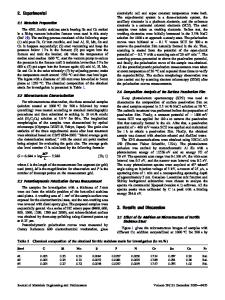Effect of ferrosilicon addition on the composition of inclusions in 16Cr-14Ni-Si stainless steel melts
- PDF / 332,976 Bytes
- 7 Pages / 612 x 792 pts (letter) Page_size
- 41 Downloads / 283 Views
INTRODUCTION
AUSTENITIC stainless steel melts have generally been deoxidized by the addition of ferrosilicon alloys in the argon oxygen decarburization converter. The silicon deoxidation equilibrium and the composition of inclusions in type 304 (18 mass pct Cr-8 mass pct Ni) stainless steel melts have widely been reported by many researchers.[1–6] However, recently, the use of austenitic stainless steels has been broadened to the fields of electronic assembly and the exhaust manifold system. This means that alloying elements such as nickel and silicon are needed to satisfy the required performance, for example, good formability and oxidation resistance at elevated temperatures. Because these properties are generally affected by the type of inclusions in the materials, the information of the inclusions formed during steelmaking and casting processes should be understood. Several studies regarding the composition and morphology of inclusions in the austenitic stainless steel melts are reviewed as follows. Kim et al. reported that the spinel (MgAl2O4) phase could be crystallized in the suspended CaO-SiO2-MgOAl2O3 (-TiO2) inclusion matrix as the temperature of molJOO HYUN PARK, Senior Researcher, is with the Stainless Steel Research Group, Technical Research Laboratories, POSCO, Pohang 790-785, Korea. YOUN-BAE KANG, Research Fellow, is with the Centre de Recherche en Calcul Thermochimique (CRCT), E´cole Polytechnique, Montreal, PQ H3C 3A7, Canada. Contact e-mail: [email protected] Manuscript submitted February 14, 2006. METALLURGICAL AND MATERIALS TRANSACTIONS B
ten steel (type 304) decreased from about 1923 K at AOD converter to about 1723 K at continuous casting mold.[2] From the analysis of plant data, they proposed that the aluminum content in the steel melt and MgO content in the AOD slag should be lowered to suppress the formation of spinel. The crystallization of spinel in the liquid CaOSiO2-MgO-Al2O3 inclusion matrix, with Al2O3 content greater than about 20 mass pct, has also recently been reported by Ehara et al.[5] However, the thermodynamic analysis regarding the deoxidation equilibrium is not available in these works. Nishi and Shinme observed that the content of MgO in the alumina-based inclusions, readily formed by aluminum deoxidation of type 304 stainless steel, increased with increasing basicity ([(mass pct CaO)/(mass pct SiO2)) of the CaO-SiO2-MgO-Al2O3 slags.[7] They proposed that the reduction of MgO in the slag by aluminum in molten steel at the slag/metal interface would provide small amounts of magnesium, which could react with Al2O3 inclusions, albeit less than 1 mass ppm magnesium. The similar mechanism was suggested by Todoroki et al.[3,8,9] Furthermore, they observed that the SiO2 in the slag enhanced the stability of the spinel inclusion in type 304 stainless steel melts.[9] Although the content of aluminum in molten steel was from about 0.01 to 1 mass pct in these studies, only the reduction of MgO (or CaO) was considered. However, the SiO2 could also be reduced by such a large content o
Data Loading...










